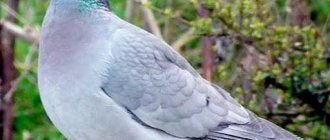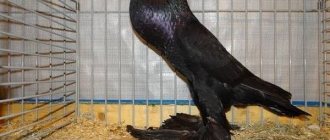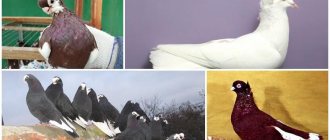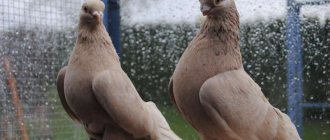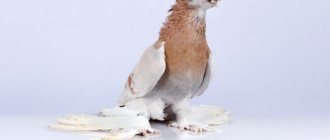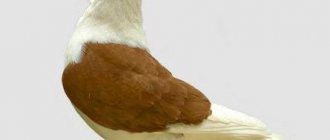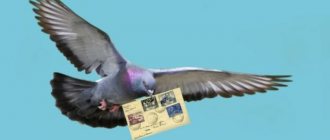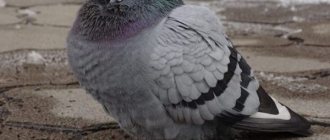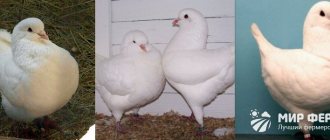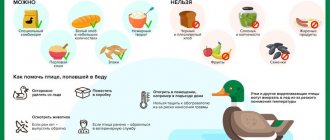Extremely popular for release during special occasions, the pink dove is a common fake. Craftsmen paint white birds, mostly Nikolaev high-flying birds, with dyes, passing them off as legendary birds. In fact, representatives of the pigeon breed of such a rare color are an endangered species. There are just over 400 of them in the world, and they are never used to decorate any celebrations.
Bird from legends and sea stories
The legend that there is a pink dove in the world appeared during the period of great geographical discoveries, when sailors who had been on long journeys told many stories, the vast majority of which were implausible.
Along with the story of the “blue bird” of happiness, a legend appeared about pink pigeons, distinguished by their grace and bright color of feathers.
For many years, pigeon breeders in many countries tried to breed a breed of pigeons with pink plumage, for which they added various ingredients containing natural dyes to their food. In some cases, they managed to change the color of the birds. Individuals with similar characteristics were sold at extremely high prices, causing a real sensation among amateurs.
But the acquired characteristics were not passed on to the offspring. Considered “pink” pigeons hatched quite ordinary chicks, even when placed in special cages for mating, which caused bewilderment among their owners.
Are there hot pink pigeons?
Judging by the description of this variety, the natural pink color does not appear bright or solid. There are types of pigeons such as purple and wine-red, but their plumage is noticeably duller and more patchy. It follows from this that in nature there are no birds of the pigeon family with similar plumage.
If you see pigeons with bright pink feathers, this only means that they are artificially colored by unscrupulous owners (for example, for wedding ceremonies and similar celebrations), and this is not at all beneficial to their health.
So, as can be seen from the above, pink birds of this species, despite their beauty, are endangered. In order for future generations to enjoy their beauty, it is necessary to take care of their existence and the preservation of their natural habitat.
Beauty that has put the species in danger of extinction
However, pigeons with pink plumage do exist in nature. These wild birds were discovered by researchers at the beginning of the 19th century on the islands of Mauritius and Aigrettes, located in the Indian Ocean.
The news of the discovery of the natural habitat of a wild pigeon, which has a pinkish coloration of the head, chest and back, caused the start of a mass hunt for it. Stuffed animals were made from the caught individuals, and they were also transported to private dovecotes (mainly in the UK).
Due to the fact that the pink pigeon could not reproduce in captivity, and the conditions of its habitat in the wild deteriorated sharply, the number of individuals of this species began to decline rapidly.
According to official statistics, in 1991 the number of birds living in the wild was about 10 individuals, and the species was on the verge of complete destruction.
Since 1970, several well-known nurseries in the USA and Germany, creating conditions similar to natural ones, have tried to start breeding pink pigeons in captivity.
But for a long time the birds refused to lay eggs and hatch chicks. Only in the mid-90s of the last century did they begin to produce offspring in captivity.
If you are interested in history, then in the article “Passenger Pigeons” you will find information about one of the completely extinct breeds.
Pink pigeon: population and protection of the subspecies
By the mid-19th century, the pink pigeon was included in the list of rare birds. The reasons were strong: in the late 50s there were only 40-50 individuals in the wild, and by 1990 this figure had plummeted to 10.
Experts sounded the alarm, and it was decided to carry out a set of measures to restore the population. An important mission was entrusted to the Darrell Wildlife Conservation Fund. As part of the program, exotic birds began to be bred at the zoo on the British island of Jersey.
Each representative of the exotic breed wears a bracelet on its paw so that experts can track population changes
The forced measures yielded excellent results. As the young grew older, they were released into the island environment, and by 2006, 370-400 exotic winged birds already lived in the usual climate. About 250 of them were adult birds that were already ready to give birth.
Important! The population of pink pigeons is still in danger today. The birds have not spread widely, but even these small flocks are threatened by mongooses, macaques, wild cats and rats. Animals eat clutches of eggs before the babies hatch.
Experts are confident that in the modern world the pink dove will not be able to survive if all conservation and restoration procedures are stopped overnight. These include measures to protect birds from predators and active breeding in captivity. And the main culprit in this situation is the person who cuts down forests and pollutes nature.
Monogamous and low fertile
Like birds of other breeds, the pink pigeon is monogamous. It mates for life and carefully protects its own territory, nest and offspring.
Unlike their counterparts, birds of this breed are not very fertile. During the year, the female lays eggs only once (usually two). She incubates the eggs at night and in the morning, and during the day the male replaces her.
The chicks begin to fly on the 20th day after hatching from the nest, but until full puberty (one year of life) they are under the care of their parents.
The female pink pigeon is capable of laying eggs throughout her life, but the male loses reproductive functions after reaching 11 years of age.
Thanks to a set of environmental measures and the closure of a number of areas in Mauritius and Egret to tourists, the populations of pink pigeons began to gradually restore their numbers. Zoos played a huge role in this, where today about 150 pink pigeons live, and grown young birds are periodically released into their natural habitat.
Today, scientists declare the existence of 5 populations of pink pigeons living in natural conditions (about 400 pieces). Birds create flocks of 20-25 individuals and collect food together, although they prefer to nest in isolation from each other.
External characteristics of the breed
A true wild pink pigeon does not have the bright plumage that you might imagine. Representatives of this breed received their name for the pale pink (powdery) color of the plumage of the head and body, as well as the tail feathers of a reddish or red hue. Wings that are brown or dark gray in color spoil the exterior somewhat.
These are small birds, rarely reaching a length of 38 cm and a weight of 350 g. They have a powerful beak, smooth plumage and powerful four-fingered paws of a reddish color without feathers.
The average lifespan of individuals of this breed is about 18-20 years, and males, which are much larger and tougher than females, also live much longer than them.
Among the aborigines there is a belief that birds, in addition to their main food, periodically feed on the fruits of the poisonous fangama tree, which is why they acquired such unusual plumage. Therefore, pink pigeons are one of the few species that have not been eaten by humans.
Main groups of pigeons
There are many people in Russia who breed decorative pigeons. In their enclosures you can find a large number of different breeds of birds. Most people who are far from pigeon breeding distinguish them only by the color of their plumage.
Pigeons that have the same uniform color can form groups of different breeds of birds. They are called doper.
White dove
A striking representative of decorative pigeons with a pure white color is the Ostankino pigeon. Very often, representatives of this breed are called pigeons of peace. This is due to the fact that the image of the Ostankino dove became the emblem of the VI World Youth Festival. Birds of this species successfully combine flight qualities and decorative appearance. They are medium in size, have dark eyes, and wings reaching to the end of the tail.
Blue dove
The blue color of the plumage can be found in such decorative bird breeds as peacock pigeons. They are distinguished by the grace of movement and poses in which they can stand for quite a long time. During an excited state, representatives of the breed begin to shake their necks and fan out their tails. When walking, pigeons step on their toes, like a ballerina. In addition to the blue color of the plumage, peacock pigeons can have black, gray, red, white and other types of pure color.
Pink dove
A rare bird species listed in the Red Book. They love to live in freedom, but recently they have been able to create conditions for survival in some zoos around the world. Pigeons of this species can be found in the forests on the islands of Mauritius and Aigrettes, which are located in the Indian Ocean. The population size is extremely low. Ornithologists believe that there are no more than 400 such birds left.
The characteristic external features of the breed are the dull pink color of the feathers. Birds live in small flocks of 20-25 individuals. They can give birth once a year. The usual litter is two chicks. The lifespan of birds is up to 20 years. Pink pigeons are excellent flyers. They can cover long distances and have good maneuverability and speed.
Black dove
Black coloring can be found in pigeons of various breeds. Classic black pigeons are considered island birds that inhabit the forests of Honshu and Nampo islands in the Pacific Ocean. The black color of their plumage has a metallic sheen. The bird is under protection. The Japanese carefully monitor their population. Among other breeds of pigeons with black plumage, the birds of the curly breed look most impressive.
Colored dove
Colorful pigeons are a real feast for the eyes. The most common representatives of this bird species in Russia are German and Crimean pigeons. The feathers of German colored pigeons can be black, blue, yellow, white and red. It has orange eyes, a thin beak and a strong, long neck. Crimean colored pigeons do not have a permanent color. The eyes are silver-gray.
Green dove
The classic representative of the group of green pigeons is Reichenow. Representatives of this breed have green plumage with a yellow or olive tint. The bird's habitat is Africa and South America. Birds have good flight qualities and can cover long distances at high speed.
Brown pigeon
The most striking representatives of the group are the White-eared and Amethyst pigeons. The birds are small in size and have a short tail. White-eared pigeons are dark brown in color. The back of the birds' head is light gray, the chest and back have a bronze-green tint. Amethyst doves are dark brown with a bluish-purple tint on the head and back. The main habitat of birds is the Moluccas Islands.
Red pigeon
Representatives of this bird species are large in size. The weight of an adult can reach 340 g. Red pigeons can be found in the forests of South, Central and North America. Birds lead a solitary lifestyle and never gather in large flocks. They fly great. Their flight is high and fast. The crown of the bird's head has a greenish tint, and the color of most of the plumage is purple-brown. The bird's beak is black, the tail is gray-brown.
Russia has its own Crimean red pigeon. This is one of the oldest local breeds. The birds have a strong build and a thick beak. The plumage is painted in rust color.
Pigeon black and white
There are black and white pigeons with 4 types of physique, which are named: strong dry, raw, rough and overdeveloped tender. This group of birds includes homing pigeons, which can reach flight speeds of more than 100 km/h. Domestic decorative representatives of pigeons of this type can have various forms of coloring.
The most common are white pigeons with black tails. This color is typical for blowers and Bukhara drummers. A distinctive feature of birds is their ability to find their owner anywhere. Prominent representatives of the species are pigeons living in Australia. They have black wings and tail. White feathers on the chest and neck of the bird are only in front.
Features of habitat in the zone of strong winds
Pink pigeons are excellent flyers and are able to stay in the air for a long time. Due to the peculiarities of their habitat in their region, the birds have lost the ability to return home, covering long distances. Although within the range they find their own nests without problems. Mauritian pigeons build them from branches on trees in the thicket of the forest.
In the Indian Ocean, especially in the area of the islands of Mauritius and Aigrettes, strong winds constantly blow, periodically turning into hurricanes. That is why pink pigeons prefer to fly low, not moving far from the nesting site.
Powerful storms in 1960, 1975 and 1979, accompanied by hurricane-force wind gusts, destroyed more than half the population of these birds, putting them on the brink of extinction. Today, on Egret, pink pigeons can only be found in inaccessible high mountain areas. There they have the opportunity to hide from the wind in rock crevices and caves, and are inaccessible to poachers.
Habitat and abundance
The pink pigeon is an endemic fauna and lives in a very limited area. It can be found only in the evergreen forests of the southern part of the island of Mauritius (an island state) and on the eastern coast of the coral island of Egret, located in the Indian Ocean. The bird hides in the thickets of the forest among vines and greenery, where there is enough food for survival and there are conditions for a more or less safe existence.
The pink pigeon began to be considered a rare bird at the end of the 19th century, when only a few hundred individuals remained on the planet. By the end of the 20th century, their number had dropped to ten birds. And this served as a signal for taking urgent measures to save the population. Currently, thanks to measures taken to preserve the species, about 400 individuals live in natural conditions and about 200 in captivity.
Captivity
Pink pigeons are extremely fastidious birds that have not been bred in captivity for many years. The main problem was low fertility, their love of freedom and poor orientation in the area.
These birds could not be released from their enclosures, since after departure they almost never returned to the dovecote, losing orientation in the conditions of modern populated areas.
There are known cases when lost birds joined flocks of wild urban pigeons, but they died very quickly, unable to adapt to digesting local food.
The usual diet of pink pigeons living in natural conditions is:
- seeds and fruits of endemic plants of your region;
- leaves and buds of trees;
- shoots and flowers.
It is not known for certain whether pigeons of this breed consume insects and other foods of animal origin.
To compare this menu with regular food, check out the material “What to Feed Pigeons.”
